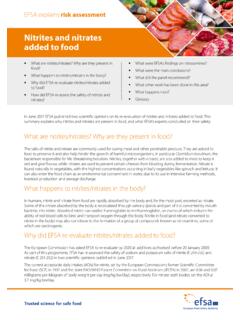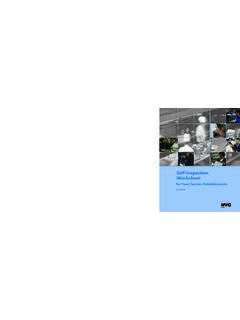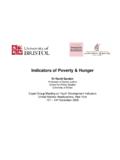Transcription of Caffeine - European Food Safety Authority
1 EFSA explains risk assessment Caffeine What is Caffeine ? Why did EFSA carry out How much Caffeine is it Does Caffeine have an adverse How does the body its risk assessment? safe to consume? effect when consumed with other process Caffeine ? What does the How much Caffeine is constituents of energy drinks . What are the risks? assessment cover? there in and/or with alcohol? How much Caffeine do we consume? What is Caffeine ? Caffeine is a naturally occurring chemical compound found in When consumed by humans, Caffeine stimulates the central plant constituents such as coffee and cocoa beans, tea leaves, nervous system, and in moderate doses increases alertness and guarana berries and the kola nut, and has a long history of reduces sleepiness. human consumption.
2 It is added to a variety of foods, such as baked pastries, ice creams, sweets, and cola drinks. Caffeine Caffeine is also found in so-called energy is also found in so-called energy drinks, alongside other ingredients such as taurine, and D-glucurono- -lactone. It is drinks, alongside other ingredients such as also present in combination with p-synephrine in a number of food supplements that are marketed for weight loss and sports taurine, and D-glucurono- -lactone. performance. Some medicines and cosmetics contain Caffeine . How does the body process Caffeine ? Taken orally, Caffeine is absorbed rapidly and completely by 50% of the Caffeine varies widely, depending on factors such as the human body. The stimulatory effects may begin 15 to 30 age, body weight, pregnancy status, medication intake and liver minutes after ingestion and last a number of hours.
3 In adults the health. In healthy adults, the average half-life is approximately half-life of Caffeine the time it takes for the body to eliminate four hours, with a range of two to eight hours. What are the risks? Short-term adverse effects on adults and children can longer term, excessive Caffeine consumption has been linked include issues related to the central nervous system such as to cardiovascular problems and, in pregnant women, stunted interrupted sleep, anxiety and behavioural changes. In the foetus development. Why did EFSA carry out its risk assessment? Some EU Member States raised concerns about the Safety and individuals consuming Caffeine together with alcohol or of Caffeine consumption in the general population and in substances found in energy drinks.
4 The European Commission specific groups, such as adults performing physical activity, responded by asking EFSA to assess the Safety of Caffeine . What does the assessment cover? EFSA's Scientific Opinion looks at the possible adverse health It does not consider the possible adverse effects of Caffeine : effects of Caffeine consumption from all dietary sources, including food supplements: in groups of the population affected by a disease or medical condition;. in the general healthy population and in sub-groups such as children, adolescents, adults, the elderly, pregnant and in combination with medicines and/or drugs of abuse;. lactating women, and people performing physical exercise;. in combination with alcohol doses which, by themselves, in combination with other substances that are present in pose a risk to health ( during pregnancy , binge drinking).
5 Energy drinks (D-glucurono- -lactone and taurine), alcohol, or p-synephrine. How much Caffeine do we consume? Average daily intakes vary among Member States, but are in the There are large differences among countries regarding the following ranges: contribution of different food sources to total Caffeine intake among adolescents. Chocolate was the main contributor in six Very elderly (75 years and above): 22-417mg surveys, coffee in four surveys, cola beverages in three, and tea Elderly (65-75 years): 23-362mg in two. In most countries chocolate (which also includes cocoa Adults (18-65 years): 37-319mg drinks) was the predominant source of Caffeine for children aged Adolescents (10-18 years): bw 3 to 10 years, followed by tea and cola drinks.
6 Children (3-10 years): bw One reason for the differences in consumption levels other Toddlers (12-36 months): bw than cultural habits is the variable concentrations of Caffeine In most surveys covered by EFSA's food Consumption Database found in some food products. Concentrations in coffee (see panel overleaf), coffee was the predominant source of beverages depend on the manufacturing process, the type of Caffeine for adults, contributing between 40% and 94% of coffee beans used, and the type of preparation ( drip coffee, total intake. In Ireland and the United Kingdom, tea was the espresso). The levels found in cocoa-based beverages depend main source, contributing 59% and 57% of total Caffeine intake on the amount and type of cocoa present in different brands.
7 Respectively. How much Caffeine is it safe to consume? On the basis of the data available, EFSA's Panel on Dietetic Intakes up to 400mg per day (about bw per day). Products, Nutrition and Allergies (NDA) reached the following consumed throughout the day do not raise Safety concerns conclusions: for healthy adults in the general population, except pregnant women. Adults Pregnant/lactating women Single doses of Caffeine up to 200mg about 3mg per kilogram of body weight (mg/kg bw) from all sources do Caffeine intakes from all sources up to 200mg per day consumed not raise Safety concerns for the general healthy adult throughout the day do not raise Safety concerns for the foetus. population. The same amount of Caffeine does not raise Safety concerns when consumed less than two hours prior Children and adolescents to intense physical exercise under normal environmental conditions.
8 No studies are available in pregnant women or The single doses of Caffeine considered to be of no concern for middle aged/elderly subjects undertaking intense physical adults (3mg/kg bw per day) may also be applied to children, exercise. because the rate at which children and adolescents process Caffeine is at least that of adults, and the studies available on the Single doses of 100mg (about bw) of Caffeine acute effects of Caffeine on anxiety and behaviour in children may affect sleep duration and patterns in some adults, and adolescents support this level. A Safety level of 3mg/kg bw particularly when consumed close to bedtime. per day is also proposed for habitual Caffeine consumption by children and adolescents. How much Caffeine is there in.
9 0 mg 20 40 60 80 100. A cup of filter coffee (200ml). A standard can of energy drink (250ml). An espresso (60ml). A cup of black tea (220ml). A standard can of cola (355ml). A bar of plain chocolate (50g). A bar of milk chocolate (50g). 0 mg 20 40 60 80 100. All figures are approximate as Caffeine content and portion sizes vary within and between countries TM-04-15-330-EN-N. Does Caffeine have an adverse effect when consumed with other constituents of energy drinks and/or with alcohol? Consumption of other constituents of energy drinks at countries would not affect the Safety of single doses of concentrations commonly present in such beverages would Caffeine up to 200mg. Up to these levels of intake, Caffeine not affect the Safety of single doses of Caffeine up to 200mg.
10 Is unlikely to mask the subjective perception of alcohol intoxication. Alcohol consumption at doses up to about bw, leading to a blood alcohol content of about the level at which you are considered unfit to drive in many How did EFSA calculate consumption levels? First, EFSA used a survey conducted in the UK to calculate Caffeine levels in different food products. This survey contained information on Caffeine concentrations from 400 samples of teas loose leaves, bags, vending machines, and instant tea and coffees filter coffee, vending machines, espresso, and instant coffee prepared at home, in workplaces or bought in cafes and other retail outlets. For foods for which the UK survey did not report Caffeine levels, an average of mean values reported in other representative surveys was used, except for energy drinks , for which the Caffeine concentration (320mg per litre) of the most popular brand was chosen.
















